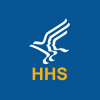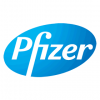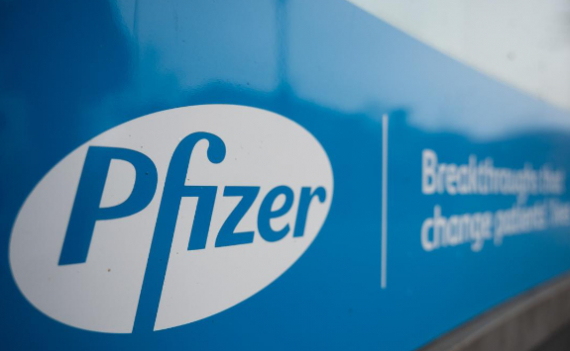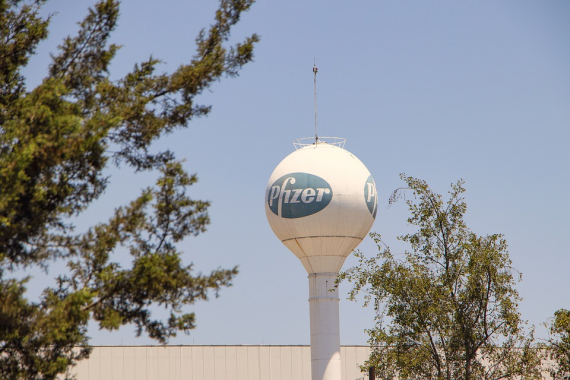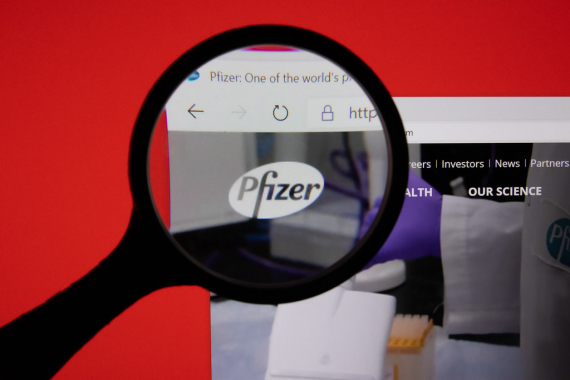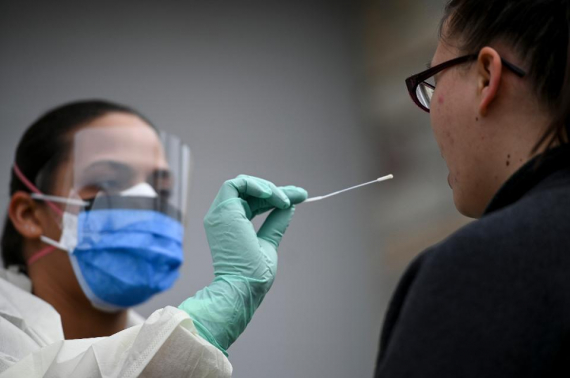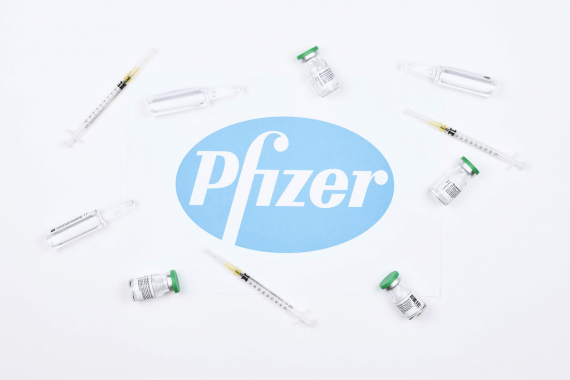
Pfizer Inc. (NYSE: PFE) today shared results from multiple studies demonstrating that the in vitro efficacy of nirmatrelvir, the active main protease (Mpro) inhibitor of PAXLOVID™ (nirmatrelvir [PF-07321332] tablets and ritonavir tablets), is maintained against the SARS-CoV-2 variant Omicron. Taken together, these in vitro studies suggest that PAXLOVID has the potential to maintain plasma concentrations many-fold times higher than the amount required to prevent Omicron from replicating in cells.
“We specifically designed PAXLOVID to retain its activity across coronaviruses, as well as current variants of concern with predominantly spike protein mutations. Following the clinical findings – showing PAXLOVID reduced risk of hospitalization or death by nearly 90% compared to placebo for high-risk patients when treated within five days of symptom onset – we are encouraged by these initial laboratory findings,” said Mikael Dolsten, M.D., Ph.D., Chief Scientific Officer and President, Worldwide Research, Development and Medical of Pfizer. “These data suggest that our oral COVID-19 therapy can be an important and effective tool in our continued battle against this devastating virus and current variants of concern, including the highly transmissible Omicron. We will continue to monitor the treatment’s activity in real-world settings and believe that these in vitro findings will continue to be validated.”
In the first of these in vitro studies conducted by Pfizer, nirmatrelvir was tested against the Mpro – an enzyme that the coronavirus needs to replicate – from several SARS-CoV-2 variants of concern (VoCs), including Omicron, in a biochemical assay. The results showed in all cases that nirmatrelvir was a potent inhibitor of its target. Nirmatrelvir’s Ki – a measure of its ability to bind to an enzyme – was approximately 1 nanomolar (nM) (or Ki fold change <1) for both the Omicron and the original Washington variant (USA-WA1/2020) in this assay, indicating its continued ability to prevent in vitro viral replication. These results, together with a crystal structure demonstrating how nirmatrelvir binds to the Omicron variant, have been submitted to the online preprint server bioRxiv.
In a second in vitro study conducted by Pfizer, nirmatrelvir was tested against several SARS-CoV-2 VoCs, including Omicron, in an antiviral, cell-based assay. Reduction in viral load was measured through polymerase chain reaction (PCR) analysis, a test designed to detect the virus. Nirmatrelvir’s EC50 – a measure of drug potency showing a concentration that is effective in producing 50% of the maximal response – was 16 nM for the Omicron variant, compared to 38 nM for the USA-WA1/2020 variant, reaffirming its robust in vitro antiviral activity. These results are in line with the values that have been observed for other VoCs (Alpha, Beta, Gamma, Delta, Lambda, and Mu) in this assay, with EC50 measures ranging from 16 to 127 nM compared to USA-WA1/2020, where EC50 was 37 nM. Results from this study have been submitted to the online preprint server bioRxiv and will be submitted to a peer-reviewed journal.
An additional study, conducted by the Icahn School of Medicine at Mount Sinai (Icahn Mount Sinai) in collaboration with Pfizer, used a SARS-CoV-2-specific immunofluorescence-based assay to similarly detect the virus and measure the in vitro potency of nirmatrelvir, as well as some other authorized/approved COVID-19 therapeutics, against VoCs. In this assay, treatments were tested against the Alpha, Beta, Delta, and Omicron variants in two cell lines. IC50 values – a measure of drug efficacy indicating the concentration needed to inhibit infection by half – ranging from 22 to 225 nM for nirmatrelvir compared to USA-WA1/2020, where the IC50 was 38 to 207 nM, were observed. Results from this study have been submitted to the online preprint server bioRxiv and will be submitted to a peer-reviewed journal. These findings are consistent with data made available to the public on December 28, 2021 by the Rega Institute at KU Leuven in Belgium via the online preprint server, bioRxiv, and provide confirmation to Pfizer’s findings that nirmatrelvir is the only orally administrable, authorized/approved compound which, to date, has been shown to have low nanomolar in vitro activity against Omicron.
“Omicron is proving itself to be a formidable and highly transmissible variant of an already detrimental virus,” said Kris White, Ph.D., Assistant Professor in the Department of Microbiology at Icahn Mount Sinai). “We are heartened to see early data showing that this oral treatment is maintaining robust in vitro antiviral activity against it, as well as other variants of concern.”
Current VoCs can be resistant to treatments that work by binding to the spike protein found on the surface of the SARS-CoV-2 virus. PAXLOVID, however, works intracellularly by binding to the highly conserved Mpro of the SARS-CoV-2 virus. Previous data have also indicated that PAXLOVID maintains in vitro efficacy against earlier and current VoCs, including Alpha, Beta, Gamma, Delta, Lambda, and Mu.
PAXLOVID is currently authorized for conditional or emergency use in several countries across the globe. Pfizer has submitted applications for regulatory approval or authorization to multiple regulatory agencies and anticipates further regulatory decisions to follow.
Please see Full Emergency Use Authorization (EUA) Prescribing Information available at www.fda.gov and www.COVID19oralRx.com.
Our Commitment to Equitable Access
Pfizer is committed to working toward equitable access to PAXLOVID for all people, aiming to deliver safe and effective antiviral therapeutics as soon as possible and at an affordable price. During the pandemic, Pfizer will offer its oral therapy through a tiered pricing approach, pending country authorization or approval, based on the income level of each country to promote equity of access across the globe. High and upper-middle income countries will pay more than lower income countries.
Pfizer continues to invest to support the manufacturing and distribution of PAXLOVID, including exploring potential contract manufacturing options. As a result of these efforts, Pfizer has raised its production projections from 80 million to 120 million courses of treatment by the end of 2022.
The company has entered into agreements with multiple countries and has initiated bilateral outreach to approximately 100 countries around the world. Additionally, Pfizer has signed a voluntary license agreement with the Medicines Patent Pool (MPP) for its oral treatment to help expand access, pending country regulatory authorization or approval, in 95 low- and middle-income countries that account for approximately 53% of the world’s population.
About PAXLOVID™ (nirmatrelvir [PF-07321332] tablets and ritonavir tablets)
PAXLOVID is a SARS-CoV-2 main protease (Mpro) inhibitor (also known as SARS-CoV-2 3CL protease inhibitor) therapy. It was developed to be administered orally so that it can be prescribed at the first sign of infection or, pending clinical success of the rest of the EPIC development program and subject to regulatory authorization, at first awareness of an exposure – potentially helping patients avoid severe illness (which can lead to hospitalization and death) or avoid disease development following contact with a household member who contracts COVID-19. Nirmatrelvir [PF-07321332], which originated in Pfizer laboratories, is designed to block the activity of the Mpro, an enzyme that the coronavirus needs to replicate. Co-administration with a low dose of ritonavir helps slow the metabolism, or breakdown, of nirmatrelvir in order for it to remain active in the body for longer periods of time at higher concentrations to help combat the virus.
Nirmatrelvir is designed to inhibit viral replication at a stage known as proteolysis, which occurs before viral RNA replication. In preclinical studies, nirmatrelvir did not demonstrate evidence of mutagenic DNA interactions.
PAXLOVID is authorized to be administered at a dose of 300 mg (two 150 mg tablets) of nirmatrelvir with one 100 mg tablet of ritonavir, given twice-daily for five days. One carton contains five blister packs of PAXLOVID, as co-packaged nirmatrelvir tablets with ritonavir tablets, providing all required doses for a full five-day treatment course.
Under the Emergency Use Authorization, the U.S. Government and State Governments decide how PAXLOVID is distributed among pharmacies, hospitals, urgent cares, and other entities. Healthcare providers and healthcare facilities should contact their state health department to determine how to access product. Additional information about how the U.S. Department of Health and Human Services will supply PAXLOVID can be found at www.PHE.gov and https://www.hhs.gov/coronavirus/covid-19-treatments-therapeutics/index.html. Locations of publicly available COVID-19 Therapeutics can be found at COVID-19 Public Therapeutic Locator | HealthData.gov.
Emergency Use Authorization Statement
PAXLOVID has not been approved, but has been authorized for emergency use by FDA under an EUA, for the treatment of mild-to-moderate COVID-19 in adults and pediatric patients (12 years of age and older weighing at least 40 kg) with positive results of direct SARS CoV-2 viral testing, and who are at high-risk for progression to severe COVID-19, including hospitalization or death.
The emergency use of PAXLOVID is only authorized for the duration of the declaration that circumstances exist justifying the authorization of the emergency use of drugs and biological products during the COVID-19 pandemic under Section 564(b)(1) of the Act, 21 U.S.C. § 360bbb-3(b)(1), unless the declaration is terminated or authorization revoked sooner.
AUTHORIZED USE
The U.S. Food and Drug Administration (FDA) has issued an Emergency Use Authorization (EUA) for the emergency use of the unapproved product PAXLOVID for the treatment of mild-to-moderate coronavirus disease 2019 (COVID-19) in adults and pediatric patients (12 years of age and older weighing at least 40 kg) with positive results of direct severe acute respiratory syndrome coronavirus 2 (SARS-CoV-2) viral testing, and who are at high risk for progression to severe COVID-19, including hospitalization or death.
LIMITATIONS OF AUTHORIZED USE
- PAXLOVID is not authorized for initiation of treatment in patients requiring hospitalization due to severe or critical COVID-19
- PAXLOVID is not authorized for use as pre-exposure or post-exposure prophylaxis for prevention of COVID-19
- PAXLOVID is not authorized for use for longer than 5 consecutive days
PAXLOVID may only be prescribed for an individual patient by physicians, advanced practice registered nurses, and physician assistants that are licensed or authorized under state law to prescribe drugs in the therapeutic class to which PAXLOVID belongs (i.e., anti-infectives).
PAXLOVID is not approved for any use, including for use for the treatment of COVID-19.
PAXLOVID is authorized only for the duration of the declaration that circumstances exist justifying the authorization of the emergency use of PAXLOVID under 564(b)(1) of the Food Drug and Cosmetic Act unless the authorization is terminated or revoked sooner.
IMPORTANT SAFETY INFORMATION
PAXLOVID is contraindicated in patients with a history of clinically significant hypersensitivity reactions (e.g., toxic epidermal necrolysis [TEN] or Stevens-Johnson syndrome) to its active ingredients (nirmatrelvir or ritonavir) or any other components of the product.
PAXLOVID is contraindicated with drugs that are highly dependent on CYP3A for clearance and for which elevated concentrations are associated with serious and/or life-threatening reactions:
- Alpha1-adrenoreceptor antagonist: alfuzosin
- Analgesics: pethidine, piroxicam, propoxyphene
- Antianginal: ranolazine
- Antiarrhythmic: amiodarone, dronedarone, flecainide, propafenone, quinidine
- Anti-gout: colchicine
- Antipsychotics: lurasidone, pimozide, clozapine
- Ergot derivatives: dihydroergotamine, ergotamine, methylergonovine
- HMG-CoA reductase inhibitors: lovastatin, simvastatin
- PDE5 inhibitor: sildenafil (Revatio®) when used for pulmonary arterial hypertension
- Sedative/hypnotics: triazolam, oral midazolam
PAXLOVID is contraindicated with drugs that are potent CYP3A inducers where significantly reduced nirmatrelvir or ritonavir plasma concentrations may be associated with the potential for loss of virologic response and possible resistance. PAXLOVID cannot be started immediately after discontinuation of any of the following medications due to the delayed offset of the recently discontinued CYP3A inducer:
- Anticancer agents: apalutamide
- Anticonvulsant: carbamazepine, phenobarbital, phenytoin
- Antimycobacterials: rifampin
- Herbal Products: St. John’s Wort (hypericum perforatum)
There are limited clinical data available for PAXLOVID. Serious and unexpected adverse events may occur that have not been previously reported with PAXLOVID use.
Risk of Serious Adverse Reactions Due to Drug Interactions: Initiation of PAXLOVID, a CYP3A inhibitor, in patients receiving medications metabolized by CYP3A or initiation of medications metabolized by CYP3A in patients already receiving PAXLOVID, may increase plasma concentrations of medications metabolized by CYP3A. Initiation of medications that inhibit or induce CYP3A may increase or decrease concentrations of PAXLOVID, respectively. These interactions may lead to:
- Clinically significant adverse reactions, potentially leading to severe, life-threatening, or fatal events from greater exposures of concomitant medications
- Clinically significant adverse reactions from greater exposures of PAXLOVID
- Loss of therapeutic effect of PAXLOVID and possible development of viral resistance
Consult Table 1 of the Fact Sheet for Healthcare Providers for clinically significant drug interactions, including contraindicated drugs. Consider the potential for drug interactions prior to and during PAXLOVID therapy; review concomitant medications during PAXLOVID therapy and monitor for the adverse reactions associated with the concomitant medications.
Hepatotoxicity: Hepatic transaminase elevations, clinical hepatitis, and jaundice have occurred in patients receiving ritonavir. Therefore, caution should be exercised when administering PAXLOVID to patients with pre-existing liver diseases, liver enzyme abnormalities, or hepatitis.
Because nirmatrelvir is co-administered with ritonavir, there may be a risk of HIV-1 developing resistance to HIV protease inhibitors in individuals with uncontrolled or undiagnosed HIV-1 infection.
Adverse events in the PAXLOVID group (≥1%) that occurred at a greater frequency (≥5 subject difference) than in the placebo group were dysgeusia (6% and <1%, respectively), diarrhea (3% and 2%), and hypertension (1% and <1%), and myalgia (1% and <1%). The proportions of subjects who discontinued treatment due to an adverse event were 2% in the PAXLOVID group and 4% in the placebo group.
Required Reporting for Serious Adverse Events and Medication Errors: The prescribing healthcare provider and/or the provider’s designee are/is responsible for mandatory reporting of all serious adverse events and medication errors potentially related to PAXLOVID within 7 calendar days from the onset of the event.
Submit adverse event and medication error reports to FDA MedWatch using one of the following methods:
- Online: https://www.fda.gov/medwatch/report.htm
- Complete and submit a postage-paid FDA Form 3500 and returning by mail/fax
- Call 1-800-FDA-1088 to request a reporting form
In addition, please provide a copy of all FDA MedWatch forms to: www.pfizersafetyreporting.com, or by fax (1-866-635-8337) or phone (1-800-438-1985).
PAXLOVID is an inhibitor of CYP3A and may increase plasma concentrations of drugs that are primarily metabolized by CYP3A. Co-administration of PAXLOVID with drugs highly dependent on CYP3A for clearance and for which elevated plasma concentrations are associated with serious and/or life-threatening events is contraindicated. Co-administration with other CPY3A substrates may require a dose adjustment or additional monitoring.
Nirmatrelvir and ritonavir are CYP3A substrates; therefore, drugs that induce CYP3A may decrease nirmatrelvir and ritonavir plasma concentrations and reduce PAXLOVID therapeutic effect.
Pregnancy: There are no available human data on the use of nirmatrelvir during pregnancy to evaluate for a drug-associated risk of major birth defects, miscarriage, or adverse maternal or fetal outcomes. Published observational studies on ritonavir use in pregnant women have not identified an increase in the risk of major birth defects. Published studies with ritonavir are insufficient to identify a drug-associated risk of miscarriage. There are maternal and fetal risks associated with untreated COVID-19 in pregnancy.
Lactation: There are no available data on the presence of nirmatrelvir in human or animal milk, the effects on the breastfed infant, or the effects on milk production. A transient decrease in body weight was observed in the nursing offspring of rats administered nirmatrelvir. Limited published data reports that ritonavir is present in human milk. There is no information on the effects of ritonavir on the breastfed infant or the effects of the drug on milk production. The developmental and health benefits of breastfeeding should be considered along with the mother's clinical need for PAXLOVID and any potential adverse effects on the breastfed infant from PAXLOVID or from the underlying maternal condition. Breastfeeding individuals with COVID 19 should follow practices according to clinical guidelines to avoid exposing the infant to COVID 19.
Contraception: Use of ritonavir may reduce the efficacy of combined hormonal contraceptives. Advise patients using combined hormonal contraceptives to use an effective alternative contraceptive method or an additional barrier method of contraception.
Pediatrics: PAXLOVID is not authorized for use in pediatric patients younger than 12 years of age or weighing less than 40 kg. The safety and effectiveness of PAXLOVID have not been established in pediatric patients. The authorized adult dosing regimen is expected to result in comparable serum exposures of nirmatrelvir and ritonavir in patients 12 years of age and older and weighing at least 40 kg as observed in adults, and adults with similar body weight were included in the trial EPIC-HR.
Systemic exposure of nirmatrelvir increases in renally impaired patients with increase in the severity of renal impairment. No dosage adjustment is needed in patients with mild renal impairment. In patients with moderate renal impairment (eGFR ≥30 to <60 mL/min), reduce the dose of PAXLOVID to 150 mg nirmatrelvir and 100 mg ritonavir twice daily for 5 days. Prescriptions should specify the numeric dose of each active ingredient within PAXLOVID. Providers should counsel patients about renal dosing instructions. PAXLOVID is not recommended in patients with severe renal impairment (eGFR <30 mL/min based on CKD-EPI formula) until more data are available; the appropriate dosage for patients with severe renal impairment has not been determined.
No dosage adjustment of PAXLOVID is needed for patients with either mild (Child-Pugh Class A) or moderate (Child-Pugh Class B) hepatic impairment. No pharmacokinetic or safety data are available regarding the use of nirmatrelvir or ritonavir in subjects with severe hepatic impairment (Child-Pugh Class C); therefore, PAXLOVID is not recommended for use in patients with severe hepatic impairment.
About Pfizer: Breakthroughs That Change Patients’ Lives
At Pfizer, we apply science and our global resources to bring therapies to people that extend and significantly improve their lives. We strive to set the standard for quality, safety and value in the discovery, development and manufacture of health care products, including innovative medicines and vaccines. Every day, Pfizer colleagues work across developed and emerging markets to advance wellness, prevention, treatments and cures that challenge the most feared diseases of our time. Consistent with our responsibility as one of the world's premier innovative biopharmaceutical companies, we collaborate with health care providers, governments and local communities to support and expand access to reliable, affordable health care around the world. For more than 170 years, we have worked to make a difference for all who rely on us. We routinely post information that may be important to investors on our website at www.Pfizer.com. In addition, to learn more, please visit us on www.Pfizer.com and follow us on Twitter at @Pfizer and @Pfizer News, LinkedIn, YouTube and like us on Facebook at Facebook.com/Pfizer.
Disclosure Notice
The information contained in this statement is as of January 18, 2022. Pfizer assumes no obligation to update forward-looking statements contained in this statement as the result of new information or future events or developments.
This statement contains forward-looking information about Pfizer’s efforts to combat COVID-19 and PAXLOVID (including qualitative assessments of available data, potential benefits, expectations for clinical trials, advanced purchase agreements and an agreement with MPP, efforts toward equitable access, the anticipated timing of data readouts, regulatory submissions, regulatory approvals or authorizations, potential to maintain antiviral activity against variants, including Omicron, planned investment and anticipated manufacturing, distribution and supply), involving substantial risks and uncertainties that could cause actual results to differ materially from those expressed or implied by such statements. Risks and uncertainties include, among other things, the uncertainties inherent in research and development, including the ability to meet anticipated clinical endpoints, commencement and/or completion dates for clinical trials, regulatory submission dates, regulatory approval dates and/or launch dates, as well as risks associated with preclinical and clinical data, including the possibility of unfavorable new preclinical, clinical or safety data and further analyses of existing preclinical, clinical or safety data, including the risk that final results from EPIC-SR could differ from the interim data; the ability to produce comparable clinical or other results including efficacy, safety and tolerability profile observed to date, in additional studies or in larger, more diverse populations following commercialization; the ability of PAXLOVID to maintain efficacy against emerging virus variants; the risk that serious and unexpected adverse events may occur that have not been previously reported with PAXLOVID use; the risk that preclinical and clinical trial data are subject to differing interpretations and assessments, including during the peer review/publication process, in the scientific community generally, and by regulatory authorities; whether regulatory authorities will be satisfied with the design of and results from these and any future preclinical and clinical studies; whether and when any drug applications or submissions to request emergency use or conditional marketing authorization for any potential indications for PAXLOVID may be filed in particular jurisdictions and if obtained, whether or when such emergency use authorization or licenses will expire or terminate; whether and when regulatory authorities in any jurisdictions may approve any applications or submissions for PAXLOVID that may be pending or filed (including a potential new drug application submission in the U.S. and submissions in other jurisdictions), which will depend on myriad factors, including making a determination as to whether the product’s benefits outweigh its known risks and determination of the product’s efficacy and, if approved, whether it will be commercially successful; decisions by regulatory authorities impacting labeling or marketing, manufacturing processes, safety and/or other matters that could affect the availability or commercial potential of PAXLOVID, including development of products or therapies by other companies; risks related to the availability of raw materials for PAXLOVID; the risk that we may not be able to create or scale up manufacturing capacity on a timely basis or maintain access to logistics or supply channels commensurate with global demand, which would negatively impact our ability to supply the estimated numbers of courses of PAXLOVID within the projected time periods; whether and when additional purchase agreements will be reached; the risk that demand for any products may be reduced or no longer exist; uncertainties regarding the impact of COVID-19 on Pfizer’s business, operations and financial results; and competitive developments.
A further description of risks and uncertainties can be found in Pfizer’s Annual Report on Form 10-K for the fiscal year ended December 31, 2020 and in its subsequent reports on Form 10-Q, including in the sections thereof captioned “Risk Factors” and “Forward-Looking Information and Factors That May Affect Future Results”, as well as in its subsequent reports on Form 8-K, all of which are filed with the U.S. Securities and Exchange Commission and available at www.sec.gov and www.pfizer.com.
Pfizer Contacts:
Media Relations
+1 (212) 733-1226
PfizerMediaRelations@pfizer.com
Investor Relations
+1 (212) 733-4848
IR@pfizer.com

 4
4




